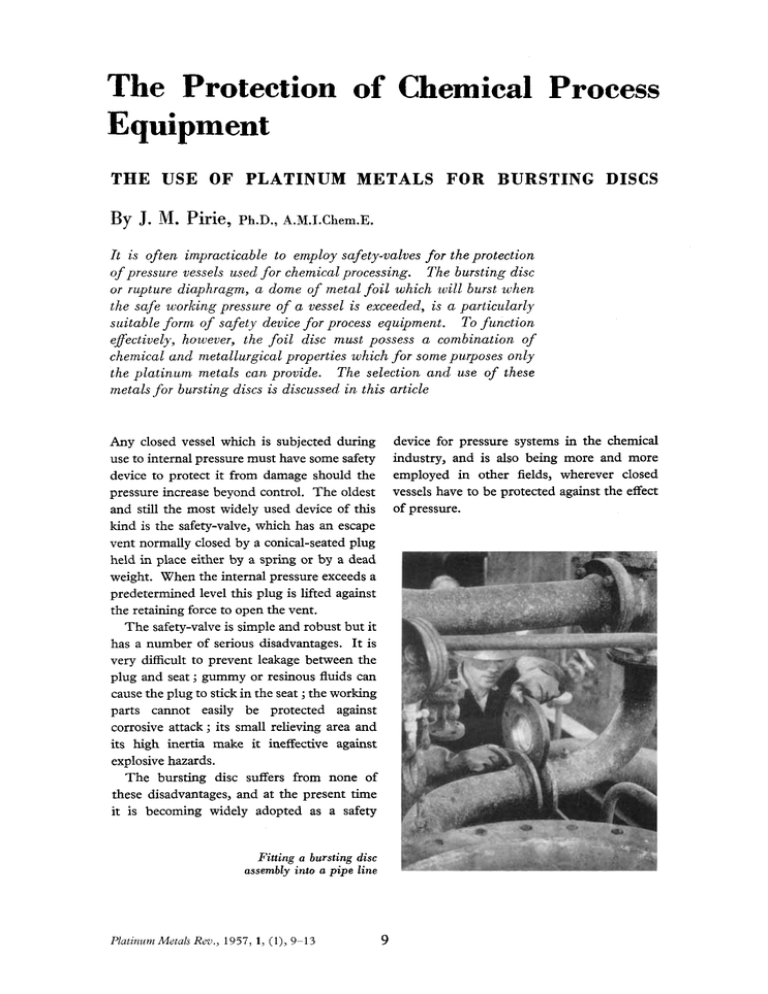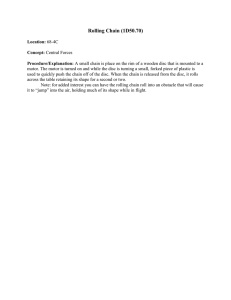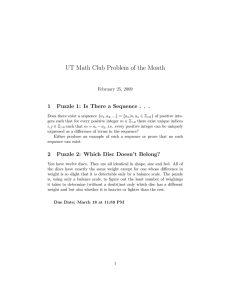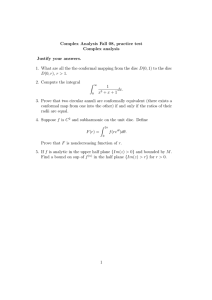this article
advertisement

The Protection of Chemical Process Equipment THE USE OF PLATINUM METALS FOR BURSTING DISCS By J. Nl. Pirie, Ph.D., A.M.1.Chem.E. It is often impracticable to employ safety-valves for the protection of pressure vessels used f o r chemical processing. The bursting disc or rupture diaphragm, a dome of metal f o i l which will burst when the safe working pressure of a vessel is exceeded, is a particularly suitable f o r m of safety device f o r process equipment. To function eflectively, however, the f o i l disc must possess a combination of chemical und metallurgical properties which f o r some purposes only the platinum metals can provide. The selection and use of these metals.for bursting discs is discussed in this article Any closed vessel which is subjected during device for pressure systems in the chemical use to internal pressure must have some safety industry, and is also being more and more device to protect it from damage should the employed in other fields, wherever closed pressure increase beyond control. The oldest vessels have to be protected against the effect and still the most widely used device of this of pressure. kind is the safety-valve, which has an escape vent normally closed by a conical-seated plug held in place either by a spring or by a dead weight. When the internal pressure exceeds a predetermined level this plug is lifted against the retaining force to open the vent. The safety-valve is simple and robust but it has a number of serious disadvantages. It is very difficult to prevent leakage between the plug and seat ; gummy or resinous fluids can cause the plug to stick in the seat ;the working parts cannot easily be protected against corrosive attack ; its small relieving area and its high inertia make it ineffective against explosive hazards. The bursting disc suffers from none of these disadvantages, and at the present time it is becoming widely adopted as a safety Fitting a bursting disc assembly into a pipe line Platinum Metals Rev., 1957, 1 , (11, 9-9 9 Standard full-face capsule-type bursting disc assemblies, with pre-domed platinum discs, stainless-steel holders and vacuum supports It may at first sight seem surprising that such an inherently simple device was not introduced many years ago, and there is little doubt that numerous attempts to develop this form of protection have been made. These attempts were always frustrated by the impossibility of obtaining very thin foil of uniform and reproducible quality, and by a lack of understanding of the behaviour of these foils when subjected to stresses near their breaking point at different temperatures. The Technical Requirements T o be successful, a bursting disc has to meet two exacting conditions: when the pressure in the system which it protects reaches a predetermined level the disc must burst, and it must withstand without failure the effect of all other lower pressures to which it may be subjected during normal working. A circular disc of thin ductile foil exposed to uniform fluid pressure on one face assumes a spheroidal form, in accordance with a relationship expressed mathematically by Platinum Metals Rev., 1957, 1 , (11, Lake and Inglis (1). The bursting pressure of a disc clamped in an orifice of a given size, held at a fixed temperature, is related both to the thickness of the disc material and to its tensile properties. T o obtain discs which will burst at an unvarying pressure it is therefore necessary to make them of an exact and uniform thickness, and to be able to control and reproduce the composition and metallurgical properties of the material. By skilful workmanship and close control, it is now possible to produce foil from which discs can be manufactured that will with certainty burst within 5 per cent of the chosen pressure, so that the first of the two requirements can be met. The second requirement is governed by more complex factors. Although a disc will at the time of installation withstand at its specified working temperature a pressure up to 5 per cent below the bursting pressure without failure, it is affected during its life by corrosive attack, while the material may creep if the pressure is near the bursting point and may suffer fatigue if fluctuating pressures are applied. All these factors tend to lower the bursting pressure and so to cause discs to fail prematurely in the range of normal working pressures. Avoiding Premature Failures Fortunately, premature failure is a nuisance rather than a danger and there are virtually no circumstances in which a disc can withstand without bursting a higher pressure than that for which it is designed. However, repeated premature failures cannot be tolerated if a plant is to operate efficiently and smoothly, and bursting discs could not find general acceptance unless these failures could be prevented. In process equipment handling corrosive fluids a certain degree of attack can usually be tolerated; for example, in a steel pressure vessel with a designed wall thickness of 1 inch, a corrosion rate of 0.005 inch per year could easily be tolerated if the initial wall thickness were I & inch. A bursting disc 0.003 inch thick attacked at the same rate would have 10 The relationship between bursting pressure and thickness of various metals, i n a 2 inch orifice at room temperature only half its original bursting pressure after four months in service. There is therefore a need to use materials of exceptionally high resistance to chemical attack and in this respect, since it is quite unaffected by virtually any corrosive condition that would be encountered in chemical process equipment, platinum is pre-eminent. For certain specific chemical conditions, palladium also has the high immunity to attack which is necessary. At low working temperatures a constant pressure of more than about 85 per cent of the rupturing pressure will cause significant creep in ductile metals. Creep-the plastic flow of a metal under a continually applied force less than that required to cause fracture -is a property strongly affected by temperature. Among the commonly used corrosion-resistant bursting disc metals, such as silver or gold, resistance to creep deteriorates rapidly with increasing temperature and, if they are to be used at much above Platinum Metals Rev., 1957, 1 , (l), IOO'C,the working load must be restricted to a comparatively small proportion of the bursting pressure, often as little as 50 or 60 per cent, to prevent early failure by progressive thinning. Platinum however has a very high melting point, a high annealing temperature and, similarly, excellent resistance to the effect of creep at temperatures up to about 400°C. Its resistance to the effect of stress-reversals is also adequate for this service. The comparatively low tensile strength of platinum and palladium is a further advantage in their employment for this purpose. With orifice sizes of say 2 to 6 inches and in the range of pressures encountered in chemical process equipment, the thickness of foil in a bursting disc is necessarily very small, usually in the range 0.001 up to 0.01 inch. T o achieve exact thicknesses and to avoid pinholes, the thicker that the material can be, the better. Because of its higher 11 A cone-ring disc holder in high tensile steel, for mounting a platinum disc on a high-pressure autoclave tensile strength, a disc of a base metal such as nickel is only about half as thick as one with the same bursting pressure made of platinum. The advantages of platinum for bursting discs are in fact so evident that one of the earliest papers dealing with bursting disc materials, by M. E. Bonyun (2), gives details of tests from which platinum was found to be the most suitable metal available. Its successful use has, however, entailed considerable development work, because, although both platinum and palladium can be prepared in a state of very high purity and foil can be rolled under close metallurgical control, they have one disadvantage in that the pure metals tend to have a coarse grain structure and, when taking a spheroidal form under the application of fluid pressure, they tend to develop a granular “orange peel” surface which gives rise to inconsistent bursting pressures. Although pure metals are in general preferred to alloys as bursting disc materials because of their greater susceptibility to close control, very accurate addition of minor constituents to the platinum metals is pos- Pre-domed platinum discs having a certi$ed bursting pressure of 200 pounds per square inch at 300°C, together with stainless steel disc holders Platinum Metals Rev., 1957, 1 , (11, 12 sible, and a series of alloys has been developed containing small additions of other noble metals. These alloys have a fine grain structure and can be rolled down to very thin foil that bursts at accurately reproducible pressures. The relationships between the bursting pressure and thickness of two platinum alloys and one palladium alloy, and also of aluminium, silver and nickel, are shown in the graph on page 11. Disc Assemblies A bursting disc cannot be considered alone; it is essentially part of a complete assembly and for accurate performance it must be fitted into a correctly designed holder. It is the general practice to pre-dome the disc by applying a hydraulic pressure of up to 90 per cent of the required bursting pressure. When the bursting pressure is subsequently applied, the disc stretches still further and eventually ruptures by tensile failure at the thinnest part of the crown. The ruptured disc opens petal-fashion, all the metal being retained at the periphery, so that it can all be recovered and the value reclaimed. The pre-doming process is an effective aid to inspection since it clearly reveals any surface imperfection or incipient pinhole in the disc. It is rarely necessary to make the whole assembly of a noble metal, although silversheathed holders are often used in service with chlorine. It is generally possible to select a base metal, such as nickel, Monel metal or stainless steel which is sufficiently resistant for the construction of the holder and the vacuum support. This support is necessary when a disc assembly is exposed to both positive and negative pressures, since without it the domed disc would be inverted under negative pressure and with only a few reversals would be sufficiently weakened to burst. Two of the accompanying figures show assemblies with platinum discs mounted in stainless steel holders and with stainless vacuum supports. These flanged holders are used for orifice sizes from 1 inch upward. For the many smaller assemblies used to protect laboratory autoclaves and the like, in which platinum discs are normally employed, the cone-ring holder shown in the accompanying figure is most suitable. If large discs to burst at high pressure are required, a disc solely of platinum might require a considerable investment, but it is practicable to manufacture composite discs in which the face in contact with the working fluid is a thin platinum foil, backed up by a thicker disc of another metal such as nickel that bears most of the stress. The bursting pressure of such a composite disc is the direct sum of those of the individual parts. Applications In chemical plant services, platinum has been principally employed in contact with hydrochloric acid vapours and chlorinated hydrocarbons, and under less corrosive conditions where the prevailing temperature is high. Patrick (3) describes a system in which platinum discs are used to protect a system containing superheated water. In certain chemical works where numbers of disc assemblies are installed the practice has been adopted of using platinum or palladium for general service, even under mildly corrosive conditions, with the purpose of having a single disc material for all services. This is preferable to using a variety of materials and by so doing entailing the risk of premature failure or accident through selection of the wrong material for a particular purpose. References G.F. Lake and N. P. Inglis 2 M.E. Bonyun ... ... 3 E.A. K.Patrick ... I Platinum Metals Rev., 1957, 1 , (11, ... ... ... Proc. Znst. Mech. Eng., 1939,142,pp. 365-375 Trans. Amer. Znst. Chem. Eng., 1935,31,pp. 256-272 Trans. Znst. Chem. Eng., 1953,31,pp. 114-119 13


